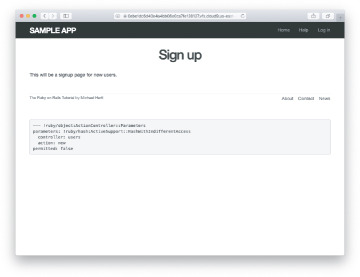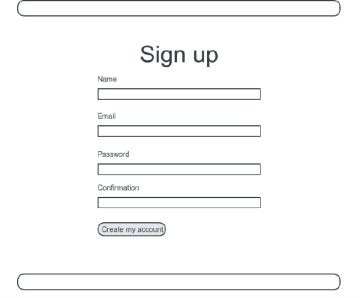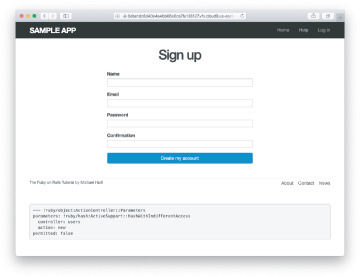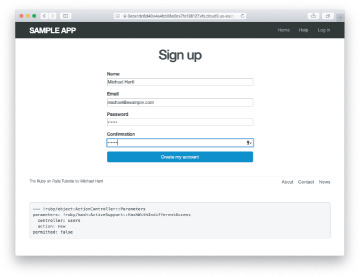7.2 Signup Form
Now that we have a working (though not yet complete) user profile page, we’re ready to make a signup form for our site. We saw in Figure 5.11 (shown again in Figure 7.12) that the signup page is currently blank: useless for signing up new users. The goal of this section is to start changing this sad state of affairs by producing the signup form mocked up in Figure 7.13.

Figure 7.12: The current state of the signup page /signup.

Figure 7.13: A mockup of the user signup page.
7.2.1 Using form_with
The heart of the signup page is a form for submitting the relevant signup information (name, email, password, confirmation). We can accomplish this in Rails with the form_with helper method, which uses an Active Record object to build a form using the object’s attributes.
Recalling that the signup page /signup is routed to the new action in the Users controller (Listing 5.43), our first step is to create the User object required as an argument to form_with. The resulting @user variable definition appears in Listing 7.14.
Listing 7.14: Adding an @user variable to the new action.
app/controllers/users_controller.rb
class UsersController < ApplicationController
def show
@user = User.find(params[:id])
end
def new
@user = User.new
end
end
The form itself appears as in Listing 7.15. We’ll discuss it in detail in Section 7.2.2, but first let’s style it a little.
Listing 7.15: A form to sign up new users.
app/views/users/new.html.erb
<% provide(:title, 'Sign up') %>
<h1>Sign up</h1>
<div class="row">
<div class="col-md-6 col-md-offset-3">
<%= form_with(model: @user) do |f| %>
<%= f.label :name %>
<%= f.text_field :name %>
<%= f.label :email %>
<%= f.email_field :email %>
<%= f.label :password %>
<%= f.password_field :password %>
<%= f.label :password_confirmation, "Confirmation" %>
<%= f.password_field :password_confirmation %>
<%= f.submit "Create my account", class: "btn btn-primary" %>
<% end %>
</div>
</div>
To make the form look a little nicer, add the SCSS shown in Listing 7.16.
Listing 7.16: CSS for the signup form (including a mixin).
app/assets/stylesheets/custom.scss
@import "bootstrap-sprockets";
@import "bootstrap";
/* mixins, variables, etc. */
$gray-medium-light: #eaeaea;
@mixin box_sizing {
-moz-box-sizing: border-box;
-webkit-box-sizing: border-box;
box-sizing: border-box;
}
.
.
.
/* forms */
input, textarea, select, .uneditable-input {
border: 1px solid #bbb;
width: 100%;
margin-bottom: 15px;
@include box_sizing;
}
input {
height: auto !important;
}
Listing 7.16 introduces the Sass mixin facility, in this case called box_sizing. A mixin allows a group of CSS rules to be packaged up and used for multiple elements, converting
input, textarea, select, .uneditable-input {
.
.
.
@include box_sizing;
}
to
input, textarea, select, .uneditable-input {
.
.
.
-moz-box-sizing: border-box;
-webkit-box-sizing: border-box;
box-sizing: border-box;
}
Once the CSS rules in Listing 7.16 have been applied, the signup page appears as in Figure 7.14.

Figure 7.14: The user signup form.
Exercises
Confirm by replacing all occurrences of f with foobar that the name of the block variable is irrelevant as far as the result is concerned. Why might foobar nevertheless be a bad choice?
7.2.2 Signup Form HTML
To understand the form defined in Listing 7.15, it’s helpful to break it into smaller pieces. We’ll first look at the outer structure, which consists of embedded Ruby opening with a call to form_with and closing with end:
<%= form_with(model: @user) do |f| %> . . . <% end %>
The presence of the do keyword indicates that form_with takes a block with one variable, which we’ve called f (for “form”).
As is usually the case with Rails helpers, we don’t need to know any details about the implementation, but what we do need to know is what the f object does: When called with a method corresponding to an HTML form element—such as a text field, radio button, or password field—f returns code for that element specifically designed to set an attribute of the @user object. In other words,
<%= f.label :name %> <%= f.text_field :name %>
creates the HTML needed to make a labeled text field element appropriate for setting the name attribute of a User model.
If you look at the HTML for the generated form by Ctrl-clicking and using the “inspect element” function of your browser, the page’s source should look something like Listing 7.17. Let’s take a moment to discuss its structure.
Listing 7.17: The HTML for the form in Figure 7.14.
<form accept-charset="UTF-8" action="/users" class="new_user"
id="new_user" method="post">
<input name="authenticity_token" type="hidden"
value="NNb6+J/j46LcrgYUC60wQ2titMuJQ5lLqyAbnbAUkdo=" />
<label for="user_name">Name</label>
<input id="user_name" name="user[name]" type="text" />
<label for="user_email">Email</label>
<input id="user_email" name="user[email]" type="email" />
<label for="user_password">Password</label>
<input id="user_password" name="user[password]"
type="password" />
<label for="user_password_confirmation">Confirmation</label>
<input id="user_password_confirmation"
name="user[password_confirmation]" type="password" />
<input class="btn btn-primary" name="commit" type="submit"
value="Create my account" />
</form>
We’ll start with the internal structure of the document. Comparing Listing 7.15 with Listing 7.17, we see that the embedded Ruby
<%= f.label :name %> <%= f.text_field :name %>
produces the HTML
<label for="user_name">Name</label> <input id="user_name" name="user[name]" type="text" />
while
<%= f.label :email %> <%= f.email_field :email %>
produces the HTML
<label for="user_email">Email</label> <input id="user_email" name="user[email]" type="email" />
and
<%= f.label :password %> <%= f.password_field :password %>
produces the HTML
<label for="user_password">Password</label> <input id="user_password" name="user[password]" type="password" />
As seen in Figure 7.15, text and email fields (type="text" and type="email") simply display their contents, whereas password fields (type="password") obscure the input for security purposes. (The benefit of using an email field is that some systems treat it differently from a text field; for example, the code type="email" will cause some mobile devices to display a special keyboard optimized for entering email addresses.)

Figure 7.15: A filled-in form with text and password fields.
As we’ll see in Section 7.4, the key to creating a user is the special name attribute in each input:
<input id="user_name" name="user[name]" - - - /> . . . <input id="user_password" name="user[password]" - - - />
These name values allow Rails to construct an initialization hash (via the params variable) for creating users using the values entered by the user, as we’ll see in Section 7.3.
The second important element is the form tag itself. Rails creates the form tag using the @user object: Because every Ruby object knows its own class (Section 4.4.1), Rails figures out that @user is of class User; moreover, since @user is a new user, Rails knows to construct a form with the post method, which is the proper verb for creating a new object (Box 3.2):
<form action="/users" class="new_user" id="new_user" method="post">
Here the class and id attributes are largely irrelevant; what’s important is action="/users" and method="post". Together, these constitute instructions to issue an HTTP POST request to the /users URL. We’ll see in the next two sections what effects this has.
(You may also have noticed the code that appears just inside the form tag:
<input name="authenticity_token" type="hidden"
value="NNb6+J/j46LcrgYUC60wQ2titMuJQ5lLqyAbnbAUkdo=" />
This code, which isn’t displayed in the browser, is used internally by Rails, so it’s not important for us to understand what it does. Briefly, it includes an authenticity token, which Rails uses to thwart an attack called a cross-site request forgery (CSRF). Knowing when it’s OK to ignore details like this is a good mark of technical sophistication (Box 1.2).)11
Exercises
Learn Enough HTML to Be Dangerous (https://www.learnenough.com/html), in which all HTML is written by hand, doesn’t cover the form tag. Why not?

